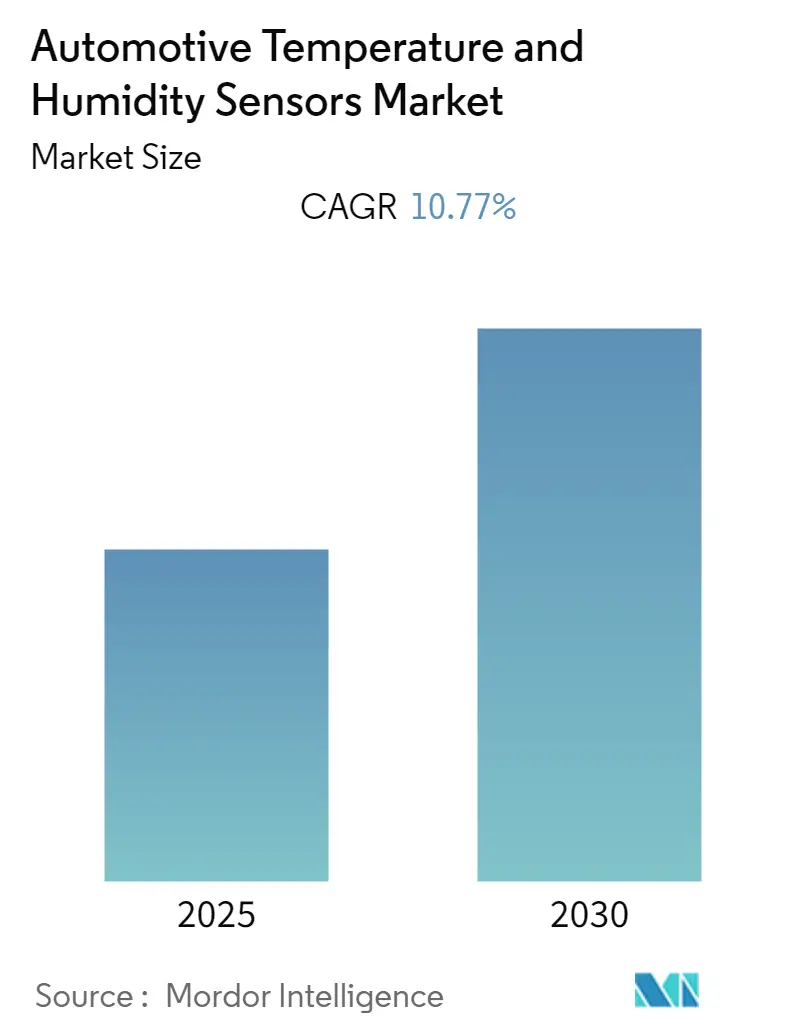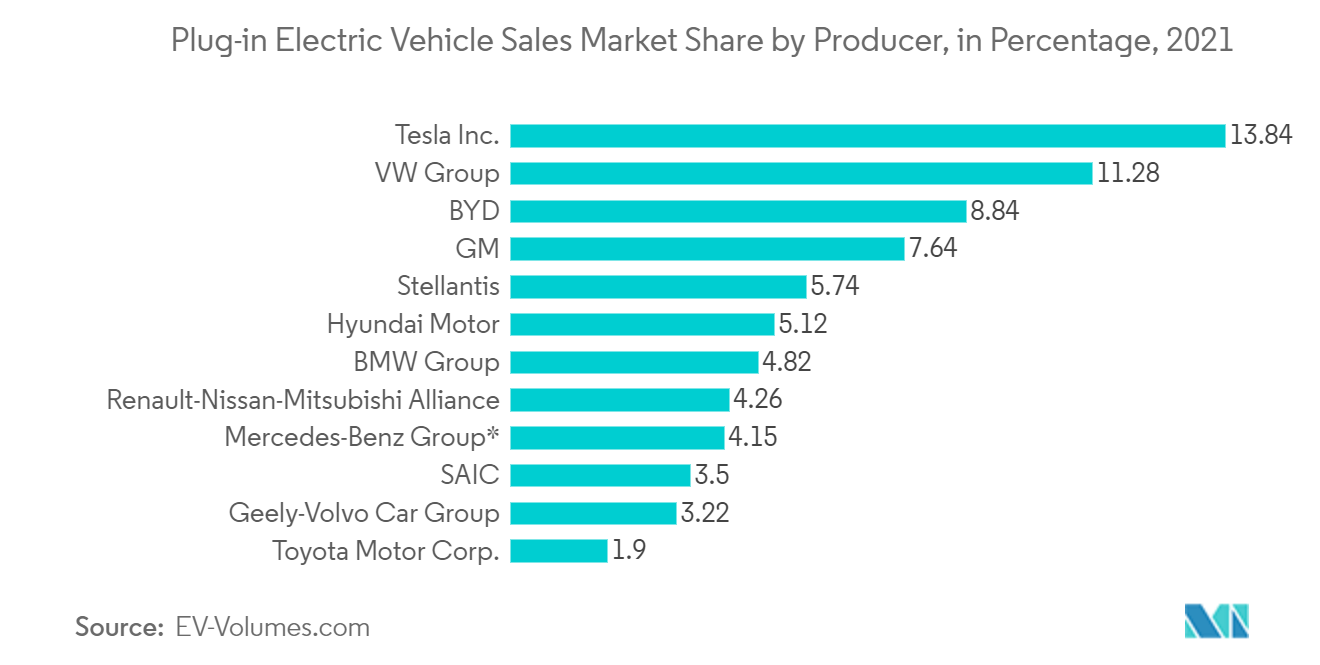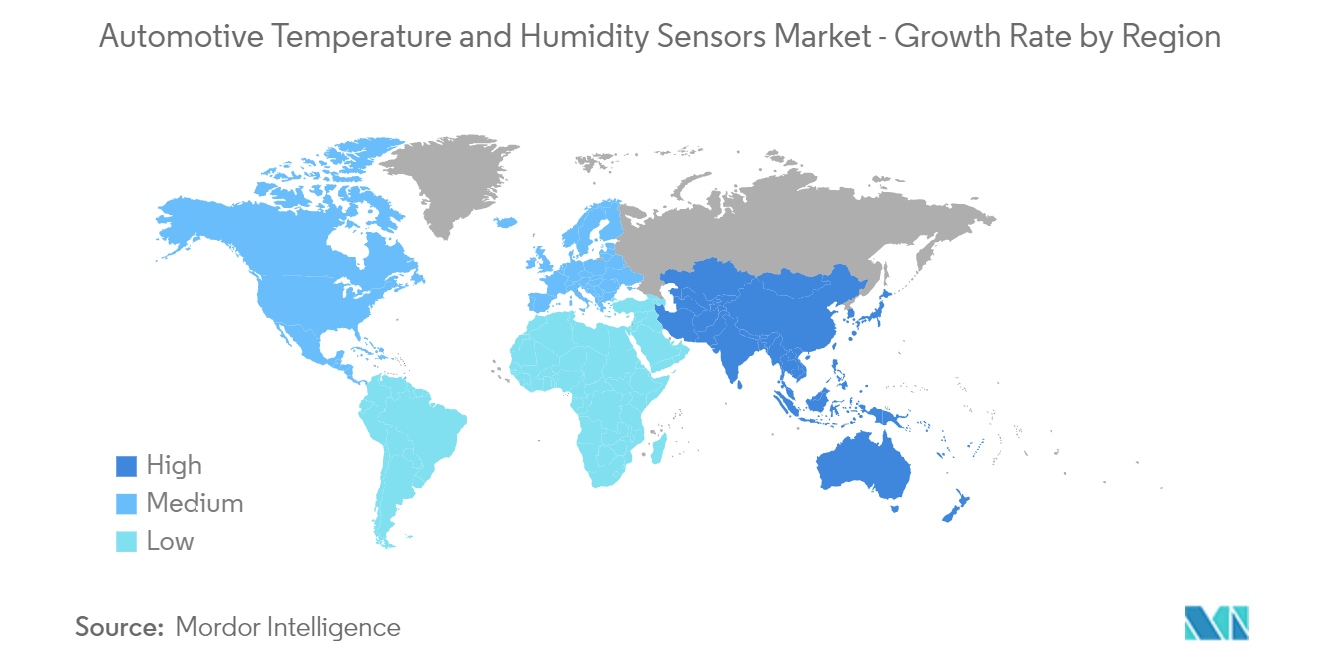Automotive Temperature and Humidity Sensors Market Size and Share

Automotive Temperature and Humidity Sensors Market Analysis by Mordor Intelligence
The Automotive Temperature and Humidity Sensors Market is expected to register a CAGR of 10.77% during the forecast period.
- Several automotive sensors monitor temperature changes, chassis solutions for roof and convertible switches, and seat position. Temperature and Humidity sensors are integrated into HVAC systems to prevent the fogging of windscreens and energy management. Vehicles frequently use humidity sensors to monitor the dew point and improve air quality. The sensors are also placed near the exhaust chamber to maintain urea quality, level, and temperature. Some of these sensors include urea pump pressure and exhaust gas temperature (EGTS) sensors.
- Every automobile is equipped with a fuel sensor to constantly check the fuel's temperature to determine whether the fuel utilization is efficient. If the engine's power is cold, a more extended period is taken to burn due to its high density. If the fuel is warm, it will take less time to burn. Here, the main problem is the varying inflow levels which could lead to the injury of certain parts of an automobile. This sensor will monitor the petroleum and ensures that injected at the right speed and temperature.
- However, the effects of COVID-19 on this market are only transient because only the production and supply chain is stalled. As the post-pandemic situation normalized, the production, supply chains, and demand for automotive temperature and humidity sensors gradually increased. The post-COVID-19 case will persuade companies to consider more advanced automotive temperature and humidity sensors to boost efficiency.
- Moreover, while safety regulations have boosted the growth of sensors, environmental regulations have been a significant driver for temperature sensor applications. And as per UBS, the global market for sensor semiconductors in autonomous vehicles is expected to reach a value of USD 30 billion by 2030. High growth in automotive sales may lead to potential growth for the automotive temperature and humidity sensors during the forecast period.
- Further, as per the study conducted by the Semiconductor Industry Association, In June 2022, The Semiconductor Industry Association (SIA) reported that sales for the semiconductor industry worldwide were USD 50.9 billion in April 2022, an increase of 21.1% over the USD 42.0 billion in April 2021 and 0.7% over the USD 50.6 billion in March 2022. The growth is mainly driven by the high demand from factory automation and a significant increase in the adoption of sensors in the automotive industry.
- It is anticipated that the high cost of the systems and installations is anticipated toThe restrict the market growth. Additionally, it is expected that the market will need help due to the growing demand for temperature and humidity sensors with better technical specifications. Potential component supply chain disruptions harm the market by reducing sales and production from a sensor standpoint.
Global Automotive Temperature and Humidity Sensors Market Trends and Insights
Rise in Electric and Autonomous Driving Vehicle is Expected to Drive the Market
- Automotive manufacturers all over the world are focusing on vehicle electrification. Cars need to charge more quickly and have a more extended range on a single charge. This implies electrical and electronics circuits within the vehicle should be able to handle extremely high power and manage losses effectively, creating a need for robust thermal-management solutions to ensure that safety-critical applications remain operational and are expected to impact automotive temperature sensors positively.
- Moreover, The demand for humidity sensors is increasing due to the automotive industry's quick electrification. The need for battery management systems is growing sharply as electric vehicles (EV) and hybrid electric vehicles gain popularity. Humidity sensors are an essential part of battery management systems because they increase the safety of electric vehicles by keeping track of the lithium-ion batteries' current, voltage, humidity, and temperature.
- Additionally, it starts the ventilation process only when the humidity level rises above the threshold, reducing power consumption and boosting the overall effectiveness of electric vehicles. This enables the market growth for humidity and temperature sensors.
- According to EV-volumes.com, Tesla was named the best-selling electric vehicle manufacturer in the world by EV Volumes after selling nearly 936,200 units in 2021. Tesla's market share is 14% based on its sales volume. Among the runners-up were BYD and Volkswagen Group. Also, registrations of plug-in electric vehicles increased in 2021, with the Chinese electric vehicle market growth. Such rise and adoption of EVs will boost the global demand for temperature and humidity sensors.
- Furthermore, The increasing adoption of autonomous cars is also expected to positively impact the market as there specific sensors on an autonomous vehicle, such as a Coolant temperature sensor or an Intake Air Temperature sensor. In May 2020, Volvo announced LIDAR-equipped cars, where the company mentioned that users could drive themselves on highways with no human intervention; the company started its production line in 2022.

Asia Pacific to Witness the Significant Growth
- The growth in the Asia-Pacific region owes to the growing automotive industry in countries such as China and India. The region's safety and emission control regulations are expected to boost the market during the forecast period significantly.
- Rapid urbanization in the region has also resulted in increased pollution levels, thereby propelling the demand for fuel-efficient vehicles that are equipped with a temperature sensor in the engine and exhaust. Major companies in the market, such as Panasonic and TDK, are based out of Japan.
- In addition, the Asia-Pacific automotive temperature sensor market benefits from ongoing pollution regulations and rising demand for safety devices like ECU. Additionally, rapid urbanization has increased emissions, driving demand for fuel-efficient cars with temperature sensors in the engine and exhaust.
- The growing adoption of electric vehicles in the developing countries of Asia Pacific also favors market growth over the forecast period. For Instance, China is the primary producer and consumer of sensors and holds a prominent position in the global market.
- China made up about 32.5% of the world's auto production in 2021; according to the China Association of Automobile Manufacturers (CAAM), China's annual production of passenger cars had surpassed that of Japan, Germany, India, and South Korea put together. In 2021, China ranked first in the world for automobile sales. Such a rise in vehicles will bring more demand for sensors such as temperature and humidity sensors in the region.

Competitive Landscape
The automotive temperature and humidity sensors market is moderately competitive and has gained a competitive edge in the past decade. However, with increased innovations and sustainable products, to maintain their position in the global market, many companies are increasing their market presence by securing new contracts by tapping new markets.
- November 2022 - TDK Corporation announces the release of the InvenSense IAM-20380HT high-temperature automotive sensor platform solution for non-safety automotive applications, as well as the expansion of the Smart Automotive line of ASIL and non-ASIL sensors. The IAM-20380HT is a standalone gyroscope sensor that can function in a wide temperature range and deliver precise measurement data for various automotive applications.
- June 2022 - Renesas Electronics has unveiled a new family of temperature and relative humidity sensors and related products. The recent relative humidity and temperature sensors provide high accuracy, rapid measurement response time, and ultra-low power consumption in a small package size to support deployment in portable devices or products made for harsh environments. These sensors can be used in automotive and other industries as well.
Automotive Temperature and Humidity Sensors Industry Leaders
Robert Bosch GmbH
TDK Corporation
TE Connectivity Ltd.
Sensata Technologies, Inc.
NXP Semiconductor N.V.
- *Disclaimer: Major Players sorted in no particular order

Recent Industry Developments
- November 2022 - ScioSense has introduced a line of digital humidity and temperature sensors with 0.1°C and 0.8% relative humidity accuracy. The primary applications of ENS21x sensors are industrial automation, automotive air conditioning, and other related applications.
- July 2022 - Tageos introduced its EOS-840 Sensor products, the market's first versatile, battery-free sensor inlays based on Asygn's next-gen AS321x chips. New RAIN RFID (UHF) products offer the most recent temperature sensing technologies. It offers EOS-840 Sensor T for temperature, EOS-840 Sensor LT for ambient light and temperature, and EOS-840 Sensor ST for mechanical strain and temperatureAsygns.
Global Automotive Temperature and Humidity Sensors Market Report Scope
Automobiles come with temperature sensors that can measure the temperature of the engine oil, gas, air, and cabin. Temperature and humidity sensing are automotive electronics' most essential and well-established features. They are helpful in systems like climate control and powertrains. These sensors are becoming more and more valuable as people's awareness of environmental costs, carbon footprints, and energy-efficient systems increases. The most effective and well-established applications are the power train, HVAC, body electronics, and alternative fuel.
The Automotive Temperature and Humidity Sensors Market are segmented by Type (Conventional, Digital), Vehicle Type (Passenger Cars, Commercial Vehicles), Application Type (Power Train, Body Electronics, Alternative Fuel Vehicles), and Geography (North America, Europe, Asia Pacific, Latin America, Middle East, and Africa). The market sizes and forecasts are provided in terms of value (USD million) for all the above segments.
| Conventional (Temperature, Humidity) |
| Digital (Temperature, Humidity) |
| Passenger Cars |
| Commercial Vehicles |
| Power Train |
| Body Electronics |
| Alternative Fuel Vehicles |
| Other Application Types |
| North America | United States |
| Canada | |
| Europe | Germany |
| United Kingdom | |
| France | |
| Spain | |
| Rest of Europe | |
| Asia Pacific | China |
| India | |
| Japan | |
| Rest of Asia Pacific | |
| Latin America | Brazil |
| Argentina | |
| Rest of Latin America | |
| Middle East and Africa | Saudi Arabia |
| United Arab Emirates | |
| South Africa | |
| Rest of Middle East and Africa |
| Type | Conventional (Temperature, Humidity) | |
| Digital (Temperature, Humidity) | ||
| Vehicle Type | Passenger Cars | |
| Commercial Vehicles | ||
| Application Type | Power Train | |
| Body Electronics | ||
| Alternative Fuel Vehicles | ||
| Other Application Types | ||
| Geography | North America | United States |
| Canada | ||
| Europe | Germany | |
| United Kingdom | ||
| France | ||
| Spain | ||
| Rest of Europe | ||
| Asia Pacific | China | |
| India | ||
| Japan | ||
| Rest of Asia Pacific | ||
| Latin America | Brazil | |
| Argentina | ||
| Rest of Latin America | ||
| Middle East and Africa | Saudi Arabia | |
| United Arab Emirates | ||
| South Africa | ||
| Rest of Middle East and Africa | ||
Key Questions Answered in the Report
What is the current Automotive Temperature and Humidity Sensors Market size?
The Automotive Temperature and Humidity Sensors Market is projected to register a CAGR of 10.77% during the forecast period (2025-2030)
Who are the key players in Automotive Temperature and Humidity Sensors Market?
Robert Bosch GmbH, TDK Corporation, TE Connectivity Ltd., Sensata Technologies, Inc. and NXP Semiconductor N.V. are the major companies operating in the Automotive Temperature and Humidity Sensors Market.
Which is the fastest growing region in Automotive Temperature and Humidity Sensors Market?
Asia Pacific is estimated to grow at the highest CAGR over the forecast period (2025-2030).
Which region has the biggest share in Automotive Temperature and Humidity Sensors Market?
In 2025, the Asia Pacific accounts for the largest market share in Automotive Temperature and Humidity Sensors Market.
What years does this Automotive Temperature and Humidity Sensors Market cover?
The report covers the Automotive Temperature and Humidity Sensors Market historical market size for years: 2019, 2020, 2021, 2022, 2023 and 2024. The report also forecasts the Automotive Temperature and Humidity Sensors Market size for years: 2025, 2026, 2027, 2028, 2029 and 2030.
Page last updated on:
Automotive Temperature and Humidity Sensors Market Report
Statistics for the 2025 Automotive Temperature and Humidity Sensors market share, size and revenue growth rate, created by Mordor Intelligence™ Industry Reports. Automotive Temperature and Humidity Sensors analysis includes a market forecast outlook for 2025 to 2030 and historical overview. Get a sample of this industry analysis as a free report PDF download.



